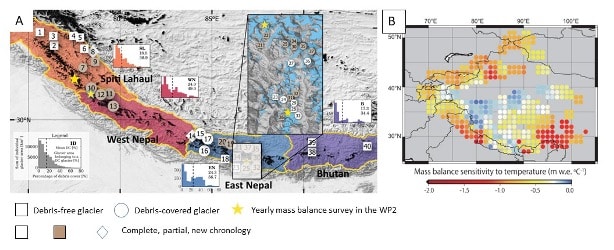CIME project - Fluctuations in Himalayan glaciers during the Holocene (60 months)
The Central Western Himalayas (India, Nepal, Bhutan) contain around 17,000 glaciers, which are essential for water, agriculture and energy for hundreds of millions of people via the Brahmaputra, Ganges and Indus rivers.
Current observations, which are limited in time, do not allow us to distinguish the glaciers that are most sensitive to climate change from those that react only slightly, or to clearly measure the contribution of natural and anthropogenic forcings.
The project CIME aims to reconstruct the history of glaciers in India, Nepal and Bhutan (WCH) during the Holocene (11,600 years ago) using geochronology and modelling. The aim is to understand the causes and rate of glacial fluctuations, by linking climate and geomorphology, in order to better predict their future evolution and the risks associated with water resources and natural hazards.
Research objectives
- Establish the calendar of changes in Holocene glaciers in different regions a WCH
- Modelling roles respective temperature variations and rainfall as well as external and internal forces associated (CO₂, volcanism...) in this evolution
- Identify roles of geomorphological variables that influenceGlaciers over the centuries(e.g. type of glacier, hypsometry a watershed, presence of a lakeetc.)
- Identify glaciers the most climate-sensitive over the 11,600 years ago
Glacier locations

A) Glaciers selected from the four climate zones
B) Sensitivity of mass balance to temperature
Organisation and partners
CIME is structured into 5 work packages (working package):
-
Coordination [WP1]
V. JomelliCEREGE
-
Glacier/current climate relationships [WP2]
-
Holocene glacial chronology [WP3]
I. Schimmelpfennig & V. JomelliCEREGE
-
Regional palaeoclimatic conditions [WP4].
-
Holocene glacial fluctuations [WP5]
N. Eckert & V. Jomelli, INRAE/CEREGE
Results
Coming soon

